A 3D Model Applied to Analyze the Mechanical Characteristic of Living Stump Slope with Different Tap Root Lengths
Abstract
:1. Introduction
2. Materials and Methods
2.1. Selection of Living Stump Tree Species
2.2. Root System Model of Living Stump
2.3. Root Systems and Soil Parameters
2.4. Living Stump Slope Model
2.4.1. Strength Reduction FEM
2.4.2. Simulation Set-Up
3. Results
3.1. Potential Sliding Surface and Safety Factors of Living Stump Slope
3.2. Roots Mechanical Characteristics
3.2.1. Tap Roots Stress Characteristics
3.2.2. Lateral Roots Stress Characteristics
3.3. Tap Roots Bending Moment Characteristics
3.4. Lateral Roots Bending Moment Characteristics
4. Discussion
4.1. The Slope Stability of Living Stumps in Different Growth Cycles
4.2. The Shear Stress of the Soil at Different Positions of the Root System
4.3. Root Mechanical Characteristics
5. Conclusions
Author Contributions
Funding
Institutional Review Board Statement
Informed Consent Statement
Data Availability Statement
Conflicts of Interest
References
- Fan, C.-C.; Chen, Y.-W. The effect of root architecture on the shearing resistance of root-permeated soils. Ecol. Eng. 2010, 36, 813–826. [Google Scholar] [CrossRef]
- Gray, D.H.; Leiser, A.T. Biotechnical Slope Protection and Erosion Control; Van Nostrand Reinhold Company Inc.: New York, NY, USA, 1982. [Google Scholar]
- Waldron, L.J. The Shear Resistance of Root-Permeated Homogeneous and Stratified Soil. Soil Sci. Soc. Am. J. 1977, 41, 843–849. [Google Scholar] [CrossRef]
- Wu, T.H.; McKinnell, W.P., III; Swanston, D.N. Strength of tree roots and landslides on Prince of Wales Island, Alaska. Can. Geotech. J. 1979, 16, 19–33. [Google Scholar] [CrossRef]
- Donn, S.; Wheatley, R.E.; McKenzie, B.M.; Loades, K.W.; Hallett, P.D. Improved soil fertility from compost amendment increases root growth and reinforcement of surface soil on slopes. Ecol. Eng. 2014, 71, 458–465. [Google Scholar] [CrossRef]
- McGuire, L.A.; Rengers, F.K.; Kean, J.W.; Coe, J.A.; Mirus, B.B.; Baum, R.L.; Godt, J.W. Elucidating the role of vegetation in the initiation of rainfall-induced shallow landslides: Insights from an extreme rainfall event in the Colorado Front Range. Geophys. Res. Lett. 2016, 43, 9084–9092. [Google Scholar] [CrossRef]
- Cohen, D.; Schwarz, M. Tree-root control of shallow landslides. Earth Surf. Dyn. 2017, 5, 451–477. [Google Scholar] [CrossRef]
- Bordoni, M.; Cislaghi, A.; Vercesi, A.; Bischetti, G.B.; Meisina, C. Effects of plant roots on soil shear strength and shallow landslide proneness in an area of northern Italian Apennines. Bull. Eng. Geol. Environ. 2020, 79, 3361–3381. [Google Scholar] [CrossRef]
- Eab, K.H.; Likitlersuang, S.; Takahashi, A. Laboratory and modelling investigation of root-reinforced system for slope stabilisation. Soils Found. 2015, 55, 1270–1281. [Google Scholar] [CrossRef]
- Donjadee, S.; Tingsanchali, S. Soil and water conservation on steep slopes by mulching using rice straw and vetiver grass clippings. Agric. Nat. Resour. 2016, 50, 75–79. [Google Scholar] [CrossRef]
- Nguyen, T.S.; Likitlersuang, S.; Jotisankasa, A. Influence of the spatial variability of the root cohesion on a slope-scale stability model: A case study of residual soil slope in Thailand. Bull. Eng. Geol. Environ. 2019, 78, 3337–3351. [Google Scholar] [CrossRef]
- Hunolt, A.E.; Brantley, E.F.; Howe, J.; Wright, A.N.; Wood, C.W. Comparison of native woody species for use as live stakes in streambank stabilization in the southeastern United States. J. Soil Water Conserv. 2013, 68, 384–391. [Google Scholar] [CrossRef]
- Wu, T.H.; Kokesh, C.M.; Trenner, B.R.; Fox, P.J. Use of Live Poles for Stabilization of a Shallow Slope Failure. J. Geotech. Geoenviron. Eng. 2014, 140, 05014001. [Google Scholar] [CrossRef]
- Greenwod, J.; Norris, J.; Wint, J. Paper for Geotechnical Engineering Special Issue. Geotech. Eng. 2004, 157, 199–207. [Google Scholar]
- Li, Y.; Wang, Y.; Wang, Y.; Ma, C. Effects of root spatial distribution on the elastic-plastic properties of soil-root blocks. Sci. Rep. 2017, 7, 1–11. [Google Scholar] [CrossRef] [PubMed]
- Hubble, T.; Docker, B.; Rutherfurd, I. The role of riparian trees in maintaining riverbank stability: A review of Australian experience and practice. Ecol. Eng. 2010, 36, 292–304. [Google Scholar] [CrossRef]
- Ji, J.; Kokutse, N.; Genet, M.; Fourcaud, T.; Zhang, Z. Effect of spatial variation of tree root characteristics on slope stability. A case study on Black Locust (Robinia pseudoacacia) and Arborvitae (Platycladus orientalis) stands on the Loess Plateau, China. Catena 2012, 92, 139–154. [Google Scholar] [CrossRef]
- Norris, J.E.; Stokes, A.; Mickovski, S.B.; Cammeraat, E.; Van Beek, R.; Nicoll, B.C.; Achim, A. Slope Stability and Erosion Control: Ecotechnological Solutions; Springer Science & Business Media: Berlin/Heidelberg, Germany, 2008. [Google Scholar]
- Song, W.F. Study on Physical Mechanism of Interface between Root System and Loess Soils; Beijing Forestry University: Beijing, China, 2006. (In Chinese) [Google Scholar]
- Liu, X.P. Finite Element Method Numerical Simulation of Forest Roots Reinforcement; Beijing Forestry University: Beijing, China, 2008. (In Chinese) [Google Scholar]
- Ji, X.L. A Roots Distribution-based Study on the Stability of Ecological Slope; Nanjing Forestry University: Nanjing, China, 2013. (In Chinese) [Google Scholar]
- Zhu, H.; Zhang, L.; Xiao, T.; Li, X. Enhancement of slope stability by vegetation considering uncertainties in root distribution. Comput. Geotech. 2017, 85, 84–89. [Google Scholar] [CrossRef]
- Li, Y.; Wang, Y.; Ma, C.; Zhang, H.; Wang, Y.; Song, S.; Zhu, J. Influence of the spatial layout of plant roots on slope stability. Ecol. Eng. 2016, 91, 477–486. [Google Scholar] [CrossRef]
- Danjon, F.; Barker, D.H.; Drexhage, M.; Stokes, A. Using three-dimensional plant root architecture in models of shallow-slope stability. Ann. Bot. 2008, 101, 1281–1293. [Google Scholar] [CrossRef]
- Fan, C.-C.; Lai, Y.-F. Influence of the spatial layout of vegetation on the stability of slopes. Plant Soil 2014, 377, 83–95. [Google Scholar] [CrossRef]
- Yang, M.; Défossez, P.; Danjon, F.; Fourcaud, T. Tree stability under wind: Simulating uprooting with root breakage using a finite element method. Ann. Bot. 2014, 114, 695–709. [Google Scholar] [CrossRef] [PubMed]
- Zhu, Y.; Yang, H.; Liu, Y.; Jiang, X.; Deng, R.; Huang, L.; Yin, P.; Lai, G. Numerical Simulation of the Combined Slope Protection Effect of Living Stump and Bamboo Anchor. Geotech. Geol. Eng. 2021, 40, 635–645. [Google Scholar] [CrossRef]
- Kokutse, N.; Fourcaud, T.; Kokou, K.; Neglo, K.; Lac, P. 3D numerical modelling and analysis of the influence of forest structure on hill slopes stability. Disaster Mitigation of Debris Flows, Slope Failures and Landslides. In Proceedings of the Interpraevent International Symposium, Niigata, Japan, 25–29 September 2006; pp. 561–567. [Google Scholar]
- Yen, C.P. Tree root patterns and erosion control. In Proceedings of the International Workshop on Soil Erosion and Its Countermeasures; Soil and Water Conservation Society of Thailand: Bangkok, Thailand, 1987; pp. 92–111. [Google Scholar]
- Ming, Y. Tree Root Anchorage: Modelling and Numerical Analyses of Key Contributing Factors of Wind Firmness of Pinus Pinaster. Ph.D. Thesis, Université de Bordeaux, Bordeaux, France, 2014. [Google Scholar]
- Watson, A.; Marden, M.; Rowan, D. Tree Species Performance and Slope Stability. Veg. Slopes Stabilisation Prot. Ecol. 1995, 161–171. [Google Scholar] [CrossRef]
- Wang, W.F.; Wu, F.S.; Xu, R.H.; He, D.P.; Qiu, F. Spatial distribution of root system at earthen ruins revealed by ground penetrating radar. J. Desert Res. 2015, 35, 1163–1170. (In Chinese) [Google Scholar]
- Li, Y.P. Research on Root Reinforcement Mechanisms and Evaluation of Vegetation Slope Stability in Beijing; Beijing Forestry University: Beijing, China, 2017. (In Chinese) [Google Scholar]
- Liang, T.; Knappett, J.A.; Duckett, N. Modelling the seismic performance of rooted slopes from individual root-soil interaction to global slope behaviour. Geotechnique 2015, 65, 995–1009. [Google Scholar] [CrossRef]
- Zhang, C.B. Fundamental and Mechanical Study on Soil Reinforcement and Slope Protection by Woody Plant Roots; Beijing Forestry University: Beijing, China, 2011. (In Chinese) [Google Scholar]
- Chen, Y.; Lin, H.; Cao, R.; Zhang, C. Slope stability analysis considering different contributions of shear strength parameters. Int. J. Geomech. 2021, 21, 04020265. [Google Scholar] [CrossRef]
- Dupuy, L.; Fourcaud, T.; Stokes, A. A numerical investigation into the influence of soil type and root architecture on tree anchorage. In Eco-and Ground Bio-Engineering: The Use of Vegetation to Improve Slope Stability. Developments in Plant and Soil Sciences; Stokes, A., Spanos, I., Norris, J.E., Cammeraat, E., Eds.; Springer: Dordrecht, The Netherlands, 2007; Volume 103. [Google Scholar] [CrossRef]
- Fourcaud, T.; Ji, J.-N.; Zhang, Z.-Q.; Stokes, A. Understanding the Impact of Root Morphology on Overturning Mechanisms: A Modelling Approach. Ann. Bot. 2008, 101, 1267–1280. [Google Scholar] [CrossRef]
- Ma, P.F.; Xia, D.; Xu, W.N.; Cheng, H.; Cai, C.F. Numerical simulation of the effect of plant roots on the stability of collapsing hillock. J. Disaster Prev. Mitig. Eng. 2019, 39, 354–364. (In Chinese) [Google Scholar] [CrossRef]
- Pollen, N. Temporal and spatial variability in root reinforcement of streambanks: Accounting for soil shear strength and moisture. Catena 2007, 69, 197–205. [Google Scholar] [CrossRef]
- Schwarz, M.; Cohen, D.; Or, D. Spatial characterization of root reinforcement at stand scale: Theory and case study. Geomorphology 2012, 171–172, 190–200. [Google Scholar] [CrossRef]
- Schwarz, M.; Giadrossich, F.; Cohen, D. Modeling root reinforcement using a root-failure Weibull survival function. Hydrol. Earth Syst. Sci. 2013, 17, 4367–4377. [Google Scholar] [CrossRef] [Green Version]
- Genet, M.; Stokes, A.; Salin, F.; Mickovski, S.B.; Fourcaud, T.; Dumail, J.-F.; Van Beek, R. The Influence of Cellulose Content on Tensile Strength in Tree Roots. Plant Soil 2005, 278, 1–9. [Google Scholar] [CrossRef]
- Matsushi, Y.; Hattanji, T.; Matsukura, Y. Mechanisms of shallow landslides on soil-mantled hillslopes with permeable and impermeable bedrocks in the Boso Peninsula, Japan. Geomorphology 2006, 76, 92–108. [Google Scholar] [CrossRef]
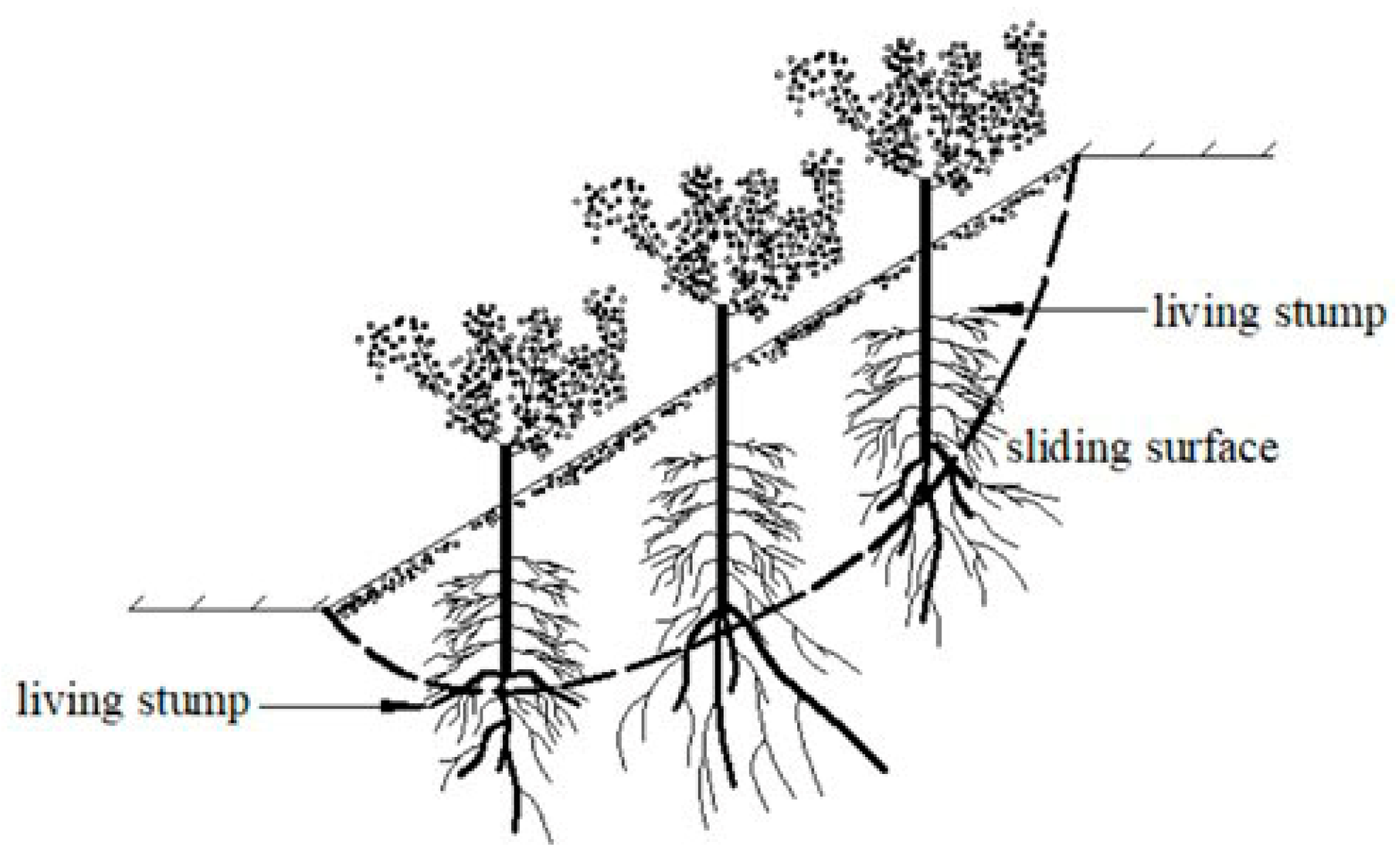
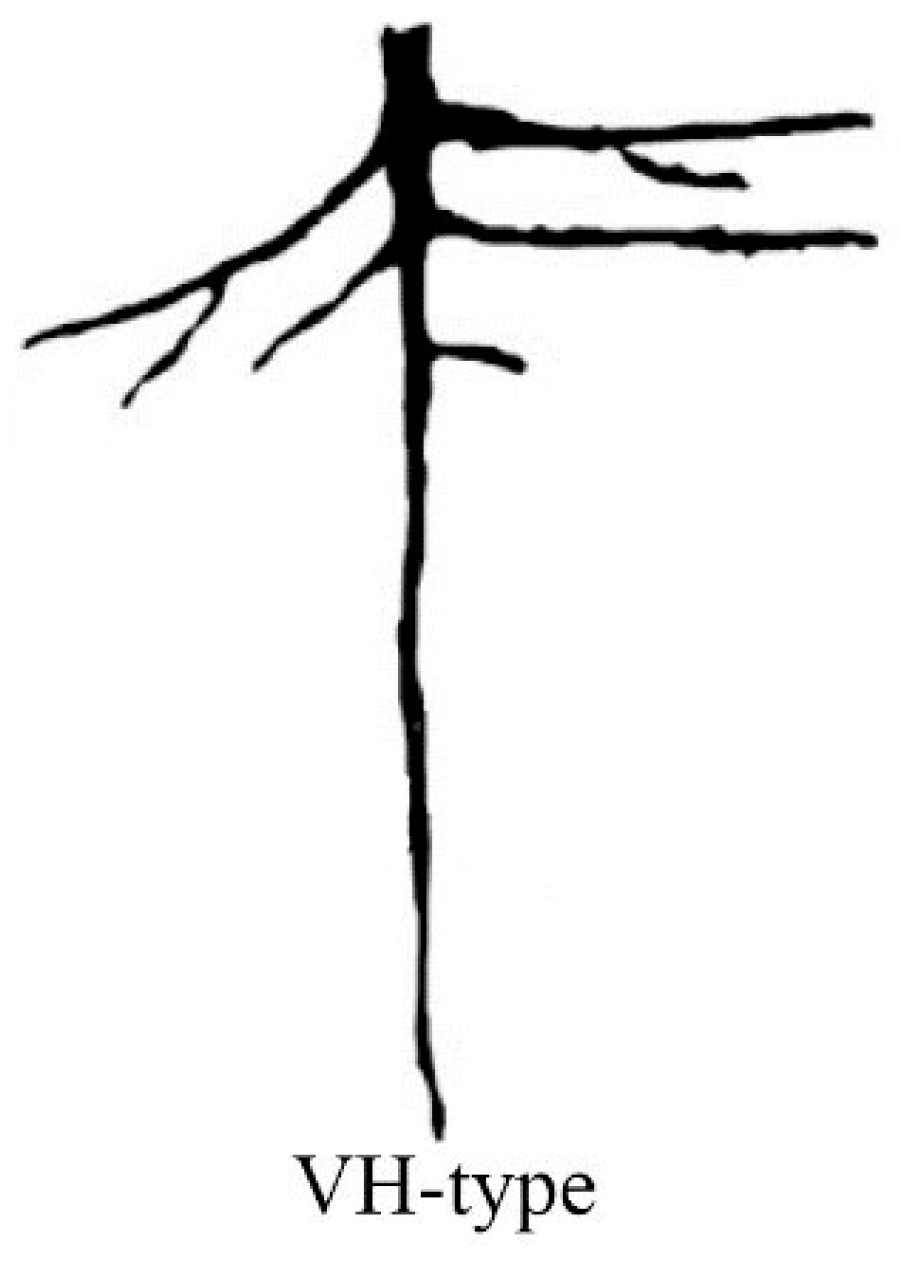



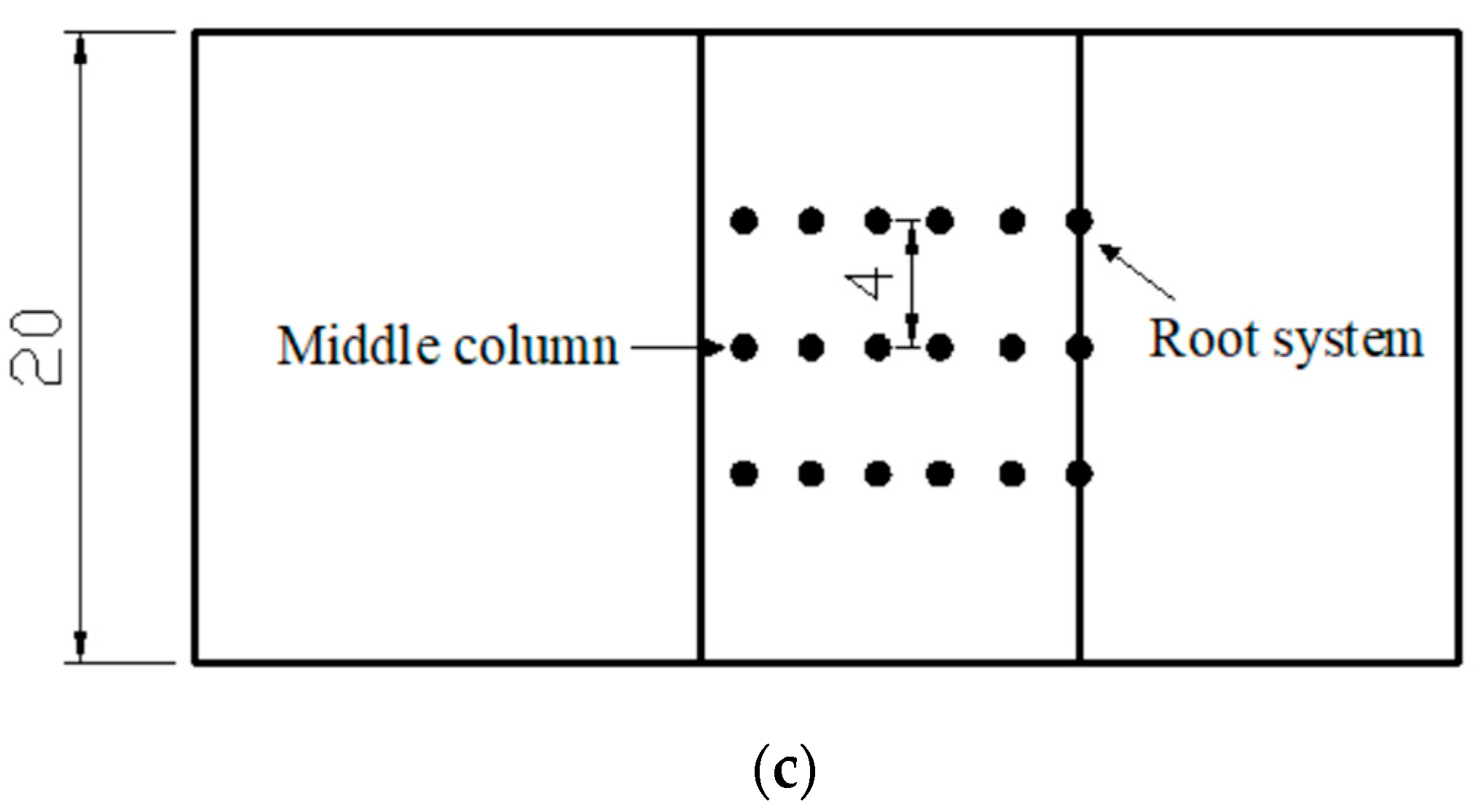
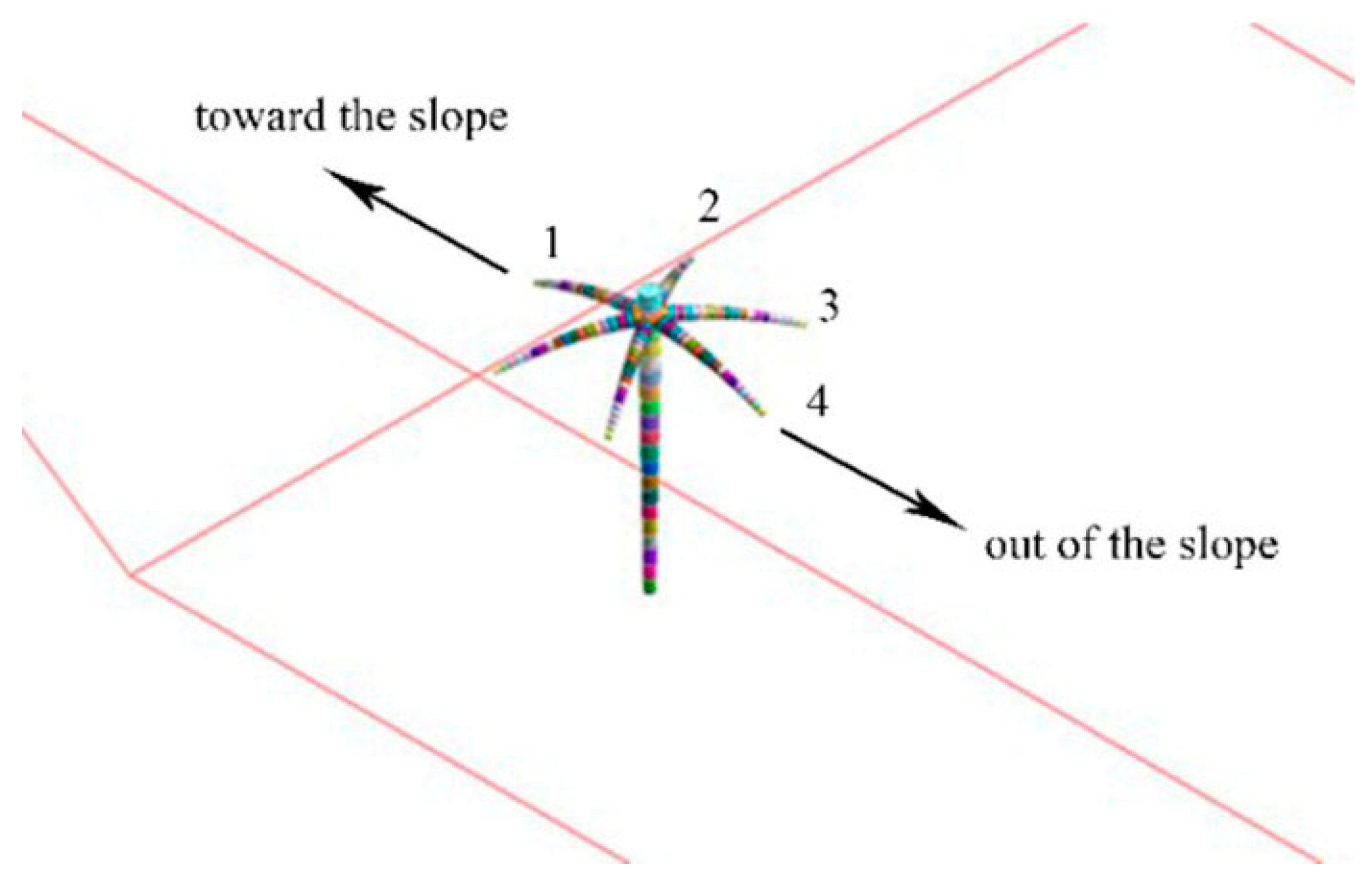






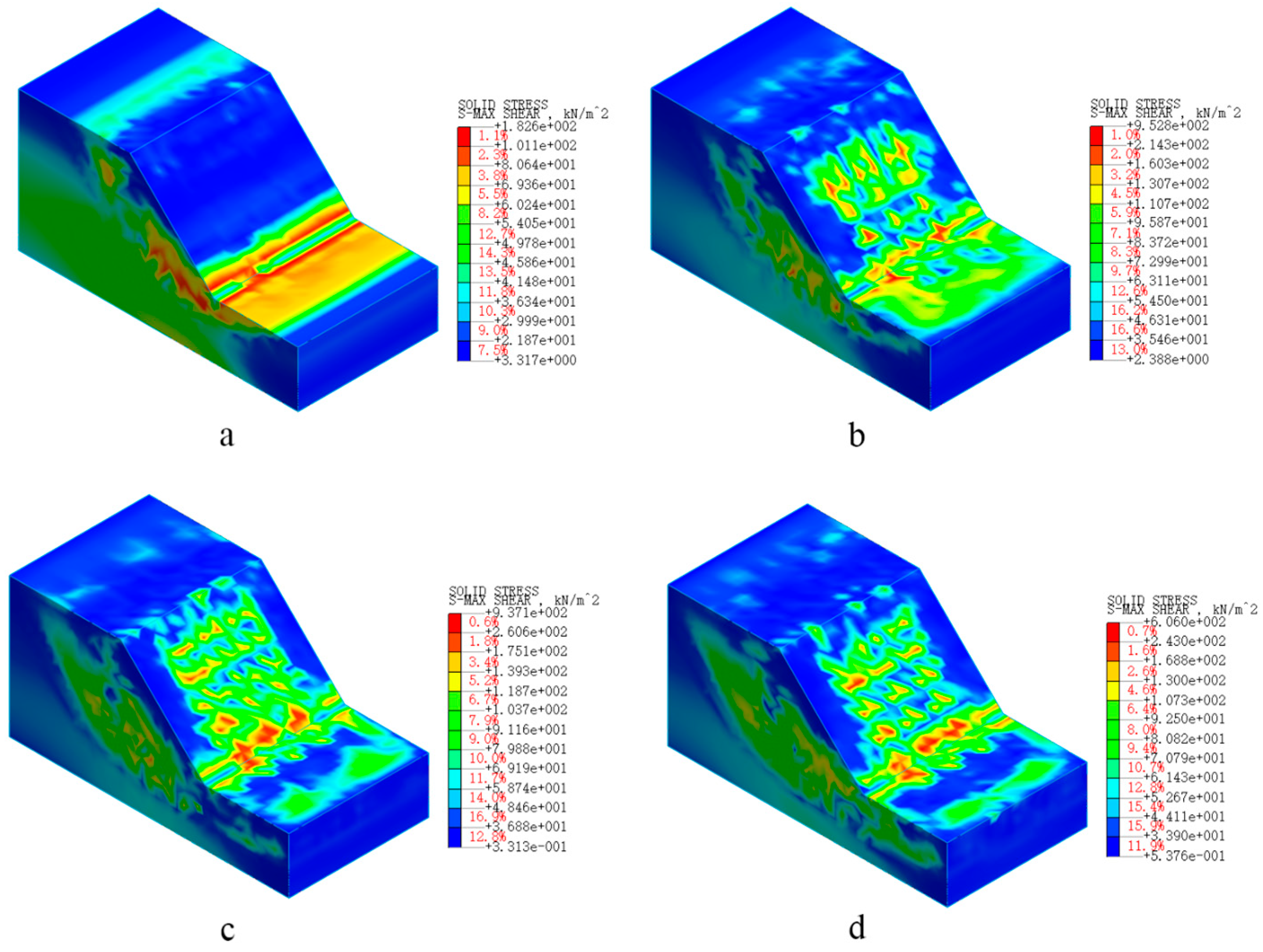
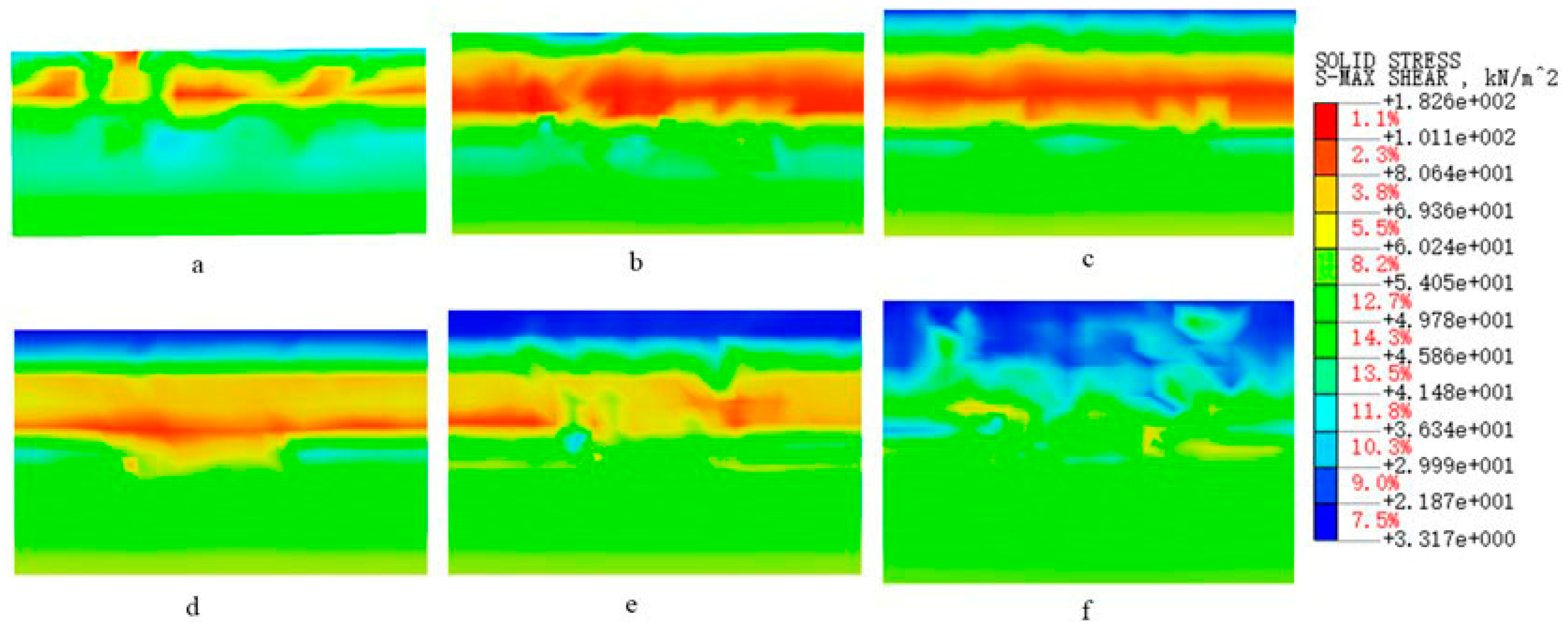
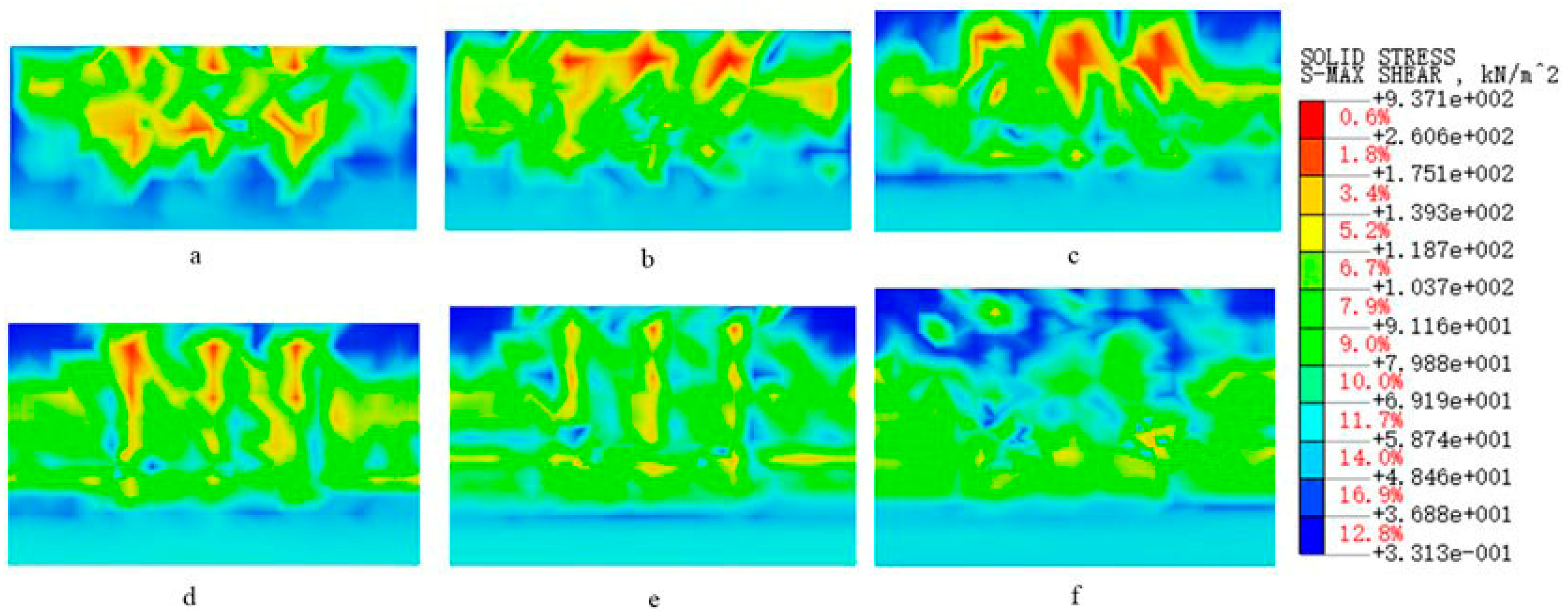
| Tap Root Length and Diameter Lateral Root Length | Lateral Root Diameter | ||
|---|---|---|---|
| Tap Root Length/m | Tap Root Diameter/m | The First Layer Lateral Root/m | The First Layer Lateral Root/m |
| 2 m | 0.1–0.05 | 1.0 | 0.08–0.05 |
| 3 m | 0.2–0.1 | 1.4 | 0.15–0.05 |
| 4 m | 0.3–0.15 | 2.0 | 0.20–0.05 |
| E/MPa | γ (kN/m3) | μ | C (kN/m2) | ϕ (°) | |
|---|---|---|---|---|---|
| Soil | 15 | 15 | 0.44 | 18 | 20 |
| Root | 450 | 11.37 | 0.3 | -- | -- |
| Work Conditions | Bare | 2 m Tap Roots | 3 m Tap Roots | 4 m Tap Roots |
|---|---|---|---|---|
| Safety factors | 0.994 | 1.112 | 1.300 | 1.400 |
Disclaimer/Publisher’s Note: The statements, opinions and data contained in all publications are solely those of the individual author(s) and contributor(s) and not of MDPI and/or the editor(s). MDPI and/or the editor(s) disclaim responsibility for any injury to people or property resulting from any ideas, methods, instructions or products referred to in the content. |
© 2023 by the authors. Licensee MDPI, Basel, Switzerland. This article is an open access article distributed under the terms and conditions of the Creative Commons Attribution (CC BY) license (https://creativecommons.org/licenses/by/4.0/).
Share and Cite
Jiang, X.; Liu, W.; Yang, H.; Li, Z.; Fan, W.; Wang, F. A 3D Model Applied to Analyze the Mechanical Characteristic of Living Stump Slope with Different Tap Root Lengths. Appl. Sci. 2023, 13, 1978. https://doi.org/10.3390/app13031978
Jiang X, Liu W, Yang H, Li Z, Fan W, Wang F. A 3D Model Applied to Analyze the Mechanical Characteristic of Living Stump Slope with Different Tap Root Lengths. Applied Sciences. 2023; 13(3):1978. https://doi.org/10.3390/app13031978
Chicago/Turabian StyleJiang, Xueliang, Wenjie Liu, Hui Yang, Zhenyu Li, Wenchen Fan, and Feifei Wang. 2023. "A 3D Model Applied to Analyze the Mechanical Characteristic of Living Stump Slope with Different Tap Root Lengths" Applied Sciences 13, no. 3: 1978. https://doi.org/10.3390/app13031978
APA StyleJiang, X., Liu, W., Yang, H., Li, Z., Fan, W., & Wang, F. (2023). A 3D Model Applied to Analyze the Mechanical Characteristic of Living Stump Slope with Different Tap Root Lengths. Applied Sciences, 13(3), 1978. https://doi.org/10.3390/app13031978







